

A light hearted essay on two recent photographic trips.
By Ian Walker. UK.
Introduction.
First, the boring stuff, all the photographs shown below were taken with a digital SLR camera and 50mm f1.8 lens, the really close-up shots use a B+W +4 close-up lens attached to the front of the cameras 50mm lens. There is a huge array of lenses available today from manufacturers like Canon and Nikon wishing you to buy their latest 15 element super-wide to super-telephoto lens that weighs near on half a kilogram with a front element that looks like a jam jar. However, don't forget the humble 50mm lens—they are cheap, light, fast [f1.8 typical] and can provide excellent pictures whilst keeping the weight of the camera down making it more pleasurable carrying it about. With a simple close-up lens attachment I can go all the way from macro to infinity and most of the time I don't miss the myriad of focal length options I could choose from on the zoom lenses.
Having just a single focal length concentrates the mind and leaves you free to compose your pictures with a minimum of fuss, I'm definitely not against zoom lenses—I have one but try one of these small lenses and you may be surprised just how versatile they are. The 50mm focal length is equivalent to about 75-80 mm on most DSLRs and providing you keep above 1/100th second it should provide images free of camera shake. This is a lot harder to achieve with the slower zoom lenses of f4-5.6 and longer focal lengths. The low noise performance on most modern DSLRs allows you to increase the ASA rating from 100 to 400 and beyond in difficult light conditions keeping your shutter speed to the figure above. Alternatively you can use flash but more often than not the harsher light this creates with a lot of the subjects below I tend to avoid using it. Macro photography using minimum depth of field is an area of photography I enjoy so you will see quite a few examples in this article and most of them were taken with the camera set at either 200 or 400 ASA.
It's photo time.
It's a warm August Saturday morning and there is quite a wind blowing...hmmm I think to myself is this a good day for macro? Not really but I'll have a go anyway. So off I pedal down the road on my trusty lean mean cycling machine [clank-clank-graunch] with camera on back and a nice flask of coffee to wake me up after an hour or two [turns out not so nice after all] and let's see if I can get some nice shots. Well I get down to one of my favourite haunts and it's all quiet, just a few birds singing in the distance and something buzzing in my ear...aaaah what' this?

'Here's looking at you kid'...its a fly taking a close interest in that large black object pointing at him or her about 6" away. Couple of seconds later 'boing' its gone, maybe it didn't like looking at itself. Lucky to catch that one.
Further down the track.
A bit further along the old track and a small clearing opens up, on my right are some deer in the park enjoying the morning sun looking at me as they always do with that suspicious twitching of the ears but too far away to get a picture, now where was I, oh yes, these freshly cut pieces of birch log look interesting.

A study on bark.
Really nice these pieces of birch with peeling bark and unlike Mr or Mrs Fly it's not moving anywhere, could have been better in this case with some more depth of field but I've just messed up with the menus again, now where's that ASA button gone?
Little things.
The sun comes out again, it's been sulky over the last half hour or so and the clouds are building up, it only pops out every now and again but it just caught the detail on this tiny feather waiving slowly in the breeze, fortunately it's very close to the ground and the stronger gusts of wind are not reaching it.

The surreal detail of a feather.
The bird is long gone leaving just a little of itself stuck to the grass, nice one birdie.
Droplets.
OK, I own up this was taken in a cold damp morning after a couple of days rain, typical of the South Pennines for summertime but I couldn't talk about macro without a few droplets this being one of my favourite subjects. The grey overcast weather suits these drops, the main colours are nicely saturated and the background becomes a nice wash of colour.
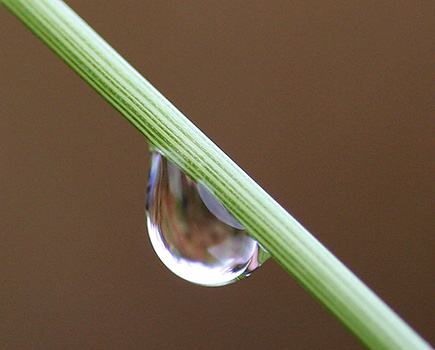
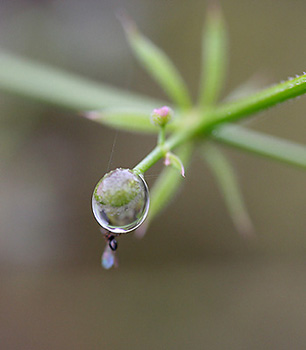
Droplets, the tiny fly on the right moved just before the shutter was released but I like the shape of the droplet!
Here I was teetering backwards and forwards trying to focus on this 'micro-fly' sitting rather nicely on the bottom of a drop of water looking straight at me, hang on...hang on yeeeeas-no and in a micro-second it turns its back on me. Oh well can't win them all.
Back to the walk.
Now where was I? Oh yes, the deer seem contented, ears still twitching so I walk on to see what we have on the other side of this large iron turn-style...squeak, squeak and the track thins out. On my left there are some open fields with trees and dry stone walls stretching into the distance but on this side of the wall there are some nice small flowers so I might have a go taking a picture. We have lots of dry stone walls in the Pennines and they all have their own character [normally falling over] but they provide many habitats for wrens and other small creatures, you often see the wrens with their heads poking out of a small opening in the wall but no mistaking the most magnificent voice for such a small bird.
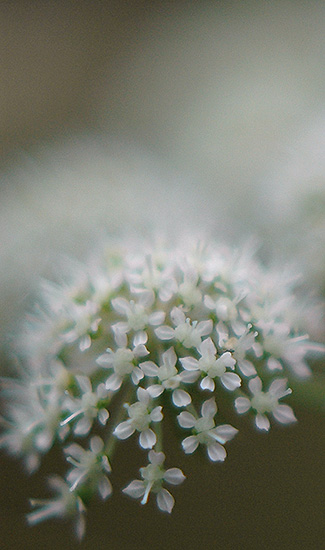
'Misty flowers'.
Each flower is barely 2 or 3mm across, quite a tricky subject but I like the effect so I'll keep this one.
Seeds and things.
Along with tiny drops of water I like taking photo's of seed heads in all their guises, this is about the time of year when many of the plants start producing these exquisite shapes so the next time you are walking along with your trusty camera near woods or hedgerows take a look at these often overlooked natural delights...so lets see what we've got down near the ground...aahh.
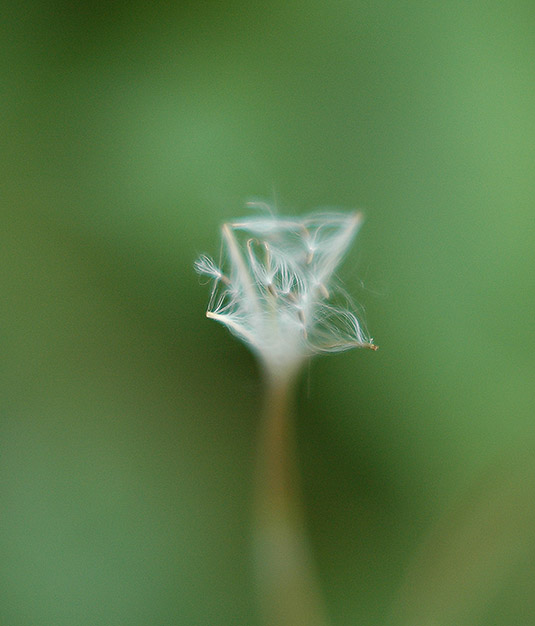
All in a tangle!
The benefit of DSLRs over most consumer digicams is their film-like noise, here the amorphous shapes and colours in the background provide a nice offset to the tiny seeds.
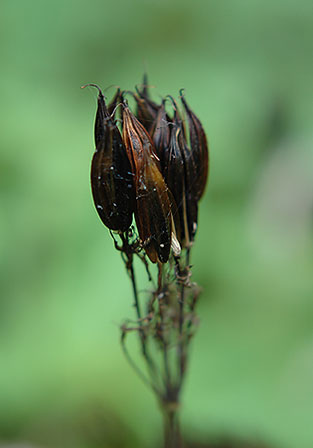
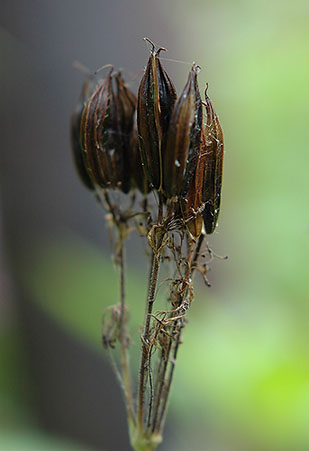
Same seeds, different angle.
The movement of camera...just a slight movement left or right can change colours dramatically.
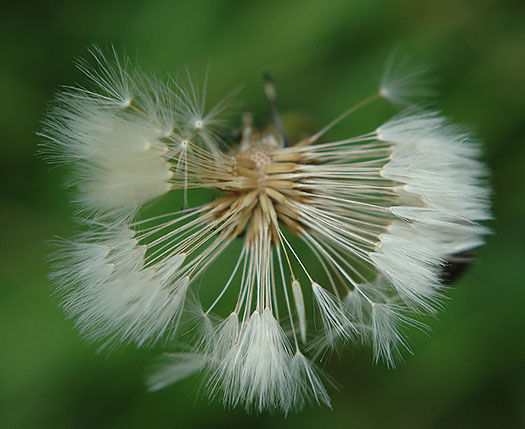
Not all seed heads need to be perfect, I like the gentle 'U' shape.
There can be a tendency to try and find dandelion seed heads complete in the typical 'fluffy ball' so often seen in macro photographs, but why not try old ones like these, no less beautiful.
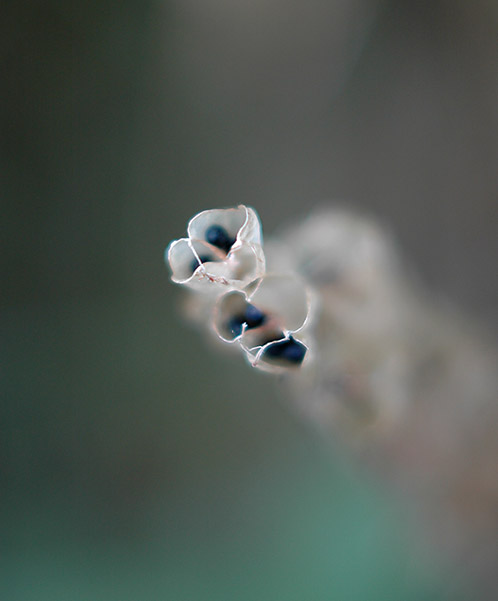
Just a single point needs to be in focus, the backdrop does the rest.
Here the B+W +4 close-up lens attached to the 50mm camera lens has caused some chromatic abberation on the seed holder tips, I get this on some shots with very bright areas, other times it's invisible.
Some black and white.
I love black and white pictures, with simple shapes of grass below, colour would almost be a distraction, the stalk on the left could have been composed to be vertical but I felt the composition was stronger for a slight angle to balance that on the right. The stalk has almost taken on a metallic sheen and I am happy if there is one just point in exact focus in this case at the top of the picture, the rest can slowly drift out.
Well, the cows are munching grass high up in the fields but growing on this side of the old dry stone walls are a variety of longer grasses many of which are dropping their tiny seeds on the ground this time of year but instead of trying to capture the seed heads I often look for just simple shapes in the stems as the picture below illustrates. Noise free images are not always necessary and here at 400 ASA set on the camera I also added a little noise in Photoshop to create a textured backdrop.
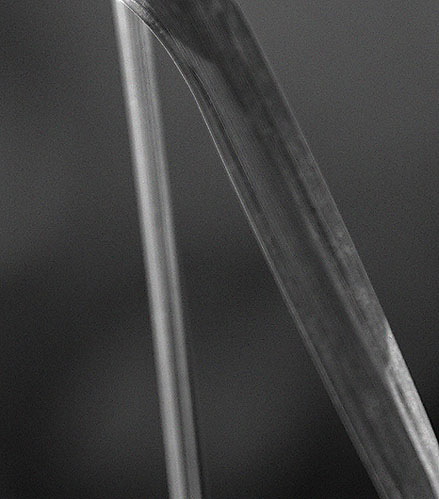
Grass.
3.5% noise has been added in Photoshop to create a textured effect to a simple composition.
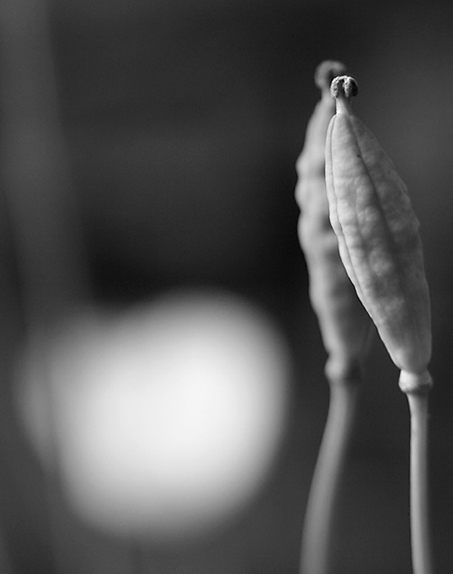
However, dropping to 200ASA on the camera provides a noise free background which in many cases can be beneficial.
Without the bright light to the left the picture would have become unbalanced.
Shapes and textures.
Sometimes I am not so interested in detail but a picture that just lets you 'drift away' in thought when looking at it, I liked this collection of dandelion 'fluff' looking rather haphazard.
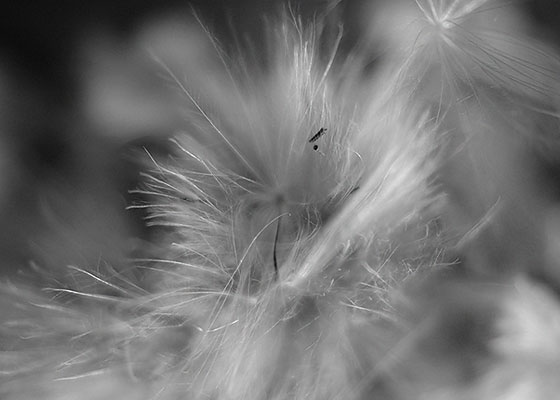
'Floating'.
Many times I put the camera down and just let nature take over for a few minutes...a stream gurgling nearby, listening to the grasshoppers and bees buzzing about, it makes a nice antidote to the technical stuff...yawn, hmmm nodding off there for a minute, what was I talking about, oh yes...
Back to that damp cool morning I was talking about earlier and the grass caught my eye, first I thought about keeping everything in focus but I changed my mind and liked the effect of being drawn to the centre of the picture with a shallow depth of field. The spiders had been busy overnight spinning their webs catching water rather than flies but on this occasion I was more absorbed in the myriad of glistening droplets on the fields of grass.
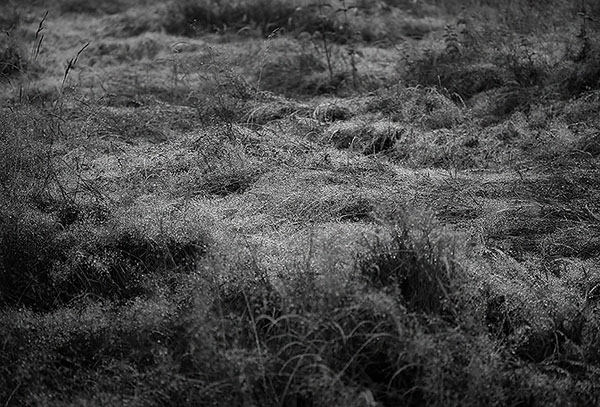
Keeping a wide aperture draws your attention to the centre point of the rain on grass.
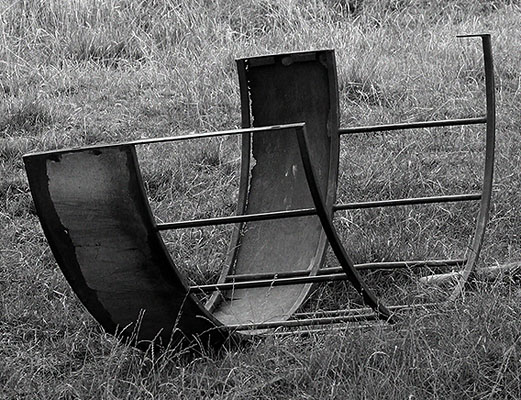
Don't forget the old iron work in fields, it can look quite interesting in black and white.
Well the sun has gone in and the wind still blows and another trip is over. The next time you are out and about in the countryside with your digicam don't forget the small things, the tiny things and the micro things just an arm reach away. Keep a sharp look out and you never know what might be around the next bend.
the end.
Comments to the author, Ian Walker, are welcomed.
Please report any Web problems or offer general comments to the Micscape Editor.
Micscape is the on-line
monthly magazine of the Microscopy UK web
site at
Microscopy-UK